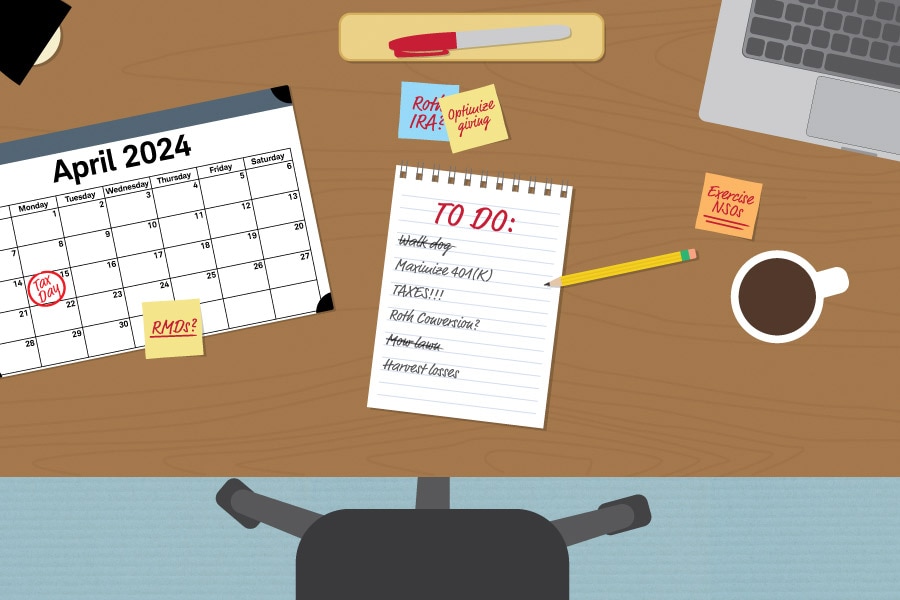
Tax Day may still be months away, but there are plenty of actions you can consider taking before then to help manage your tax bill. In fact, certain tasks should not—or in some cases cannot—wait until next year, lest you miss out on potentially important tax opportunities.
Here are the top tasks to consider before December 31—and those you have until Tax Day on April 15, 2024, to accomplish.
To consider by year-end
Take required minimum distributions (RMDs)
If you're age 73 or older, you generally must take minimum distributions from your tax-deferred retirement accounts by the end of the year. If you miss the deadline, you could be subject to a 25% penalty on the portion of your RMD you failed to withdraw.
- Use Schwab's RMD calculator (schwab.com/rmdcalculator) to help determine how much you need to withdraw.
- Learn strategies to potentially reduce your RMDs.
Maximize your 401(k)
Contributing the maximum amount to your tax-deferred employer-sponsored retirement plan can help reduce your taxable income for the current year. In 2023, the maximum contribution for 401(k)s and similar plans is $22,500 ($30,000 if age 50 or older).
Contribute to a Roth 401(k)
If your employer offers the option and you haven't maxed out your traditional 401(k), you can make after-tax contributions to a Roth 401(k) up to the $22,500 limit ($30,000 if age 50 or older)—minus whatever you might've contributed to your traditional 401(k)—before year-end.
Consider a Roth conversion
If your income exceeds Roth individual retirement account (IRA) contribution limits (see "To consider by Tax Day" below for more on Roth IRAs), you can convert the pretax savings in a traditional IRA to a Roth IRA in order to reap those tax-free withdrawals in retirement. As with any withdrawal from a tax-deferred account, the converted funds will be treated as income, so generally, you'll want to convert just enough to remain within your current tax bracket to avoid a hefty tax bill. For example, if you're single and will earn $175,000 this year, you fall into the 24% tax bracket, which ranges from $95,376 to $182,100 in 2023. That means you can convert up to $7,100 ($182,100 – $175,000) without being pushed into the next bracket.
Use Schwab's Roth IRA Conversion Calculator (schwab.com/rothcalculator) to help determine if a Roth conversion makes sense for you.
Consider a mega backdoor Roth
If permitted by your workplace retirement plan, a so-called mega-backdoor Roth allows high-income earners to save in a Roth account while eschewing the income limits of a Roth IRA and the tax consequences of a regular Roth conversion. To take advantage of this strategy, you first max out your normal, pretax 401(k) contributions for the year, then contribute after-tax dollars up to the overall account limit of $66,000 in 2023 ($73,500 if 50 or older), after which you can convert those funds to a Roth IRA. You'll want to roll over those funds as quickly as possible to avoid being taxed on any additional investment returns.
Optimize your giving
If charitable giving is part of your financial plan, act by year's end to ensure your donation is as tax-efficient as possible:
- Charitable donations: In general, you can deduct cash donations to qualified charities worth up to 60% of your adjusted gross income (AGI), which is your total gross income minus certain deductions. Donating appreciated long-term investments can be especially tax-efficient because you don't have to recognize the capital gains and you can receive a tax deduction for the full fair-market value of the donation (up to 30% of your AGI).
- Qualified charitable distribution (QCD): If you're 70½ or older, in 2023 you can donate up to $100,000 to a charity directly from your IRA using a QCD. You won't receive a tax deduction for the donation, but the gifted amount can be used to satisfy all or part of your RMD without adding to your taxable income.
Exercise nonqualified stock options (NSOs)
If your company issues NQSOs, which are taxed as ordinary income when exercised, waiting until the end of the year allows you to exercise just enough to stay within your tax bracket, thereby keeping your taxes lower than if you had exercised your options all at once.
Harvest losses
The end of the year is a great time to make sure your portfolio is still aligned with your goals. When rebalancing, you may be able to reduce your tax liability by offsetting any realized capital gains with your losses. To employ this strategy, tally up your gains, then cash out losing positions of equal value. If you have more losses than gains, you can offset up to $3,000 of ordinary income. If you do employ tax-loss harvesting, be sure not to buy the same or a similar security within 30 days to avoid the pitfalls of the wash-sale rule.
To consider by Tax Day
Maximize all other tax-deferred savings accounts
Money set aside in these tax-advantaged accounts can potentially help reduce taxable income, and with these, you'll have until Tax Day to make contributions for the prior tax year. For 2023, the maximum contributions are:
- Health savings accounts (HSAs): $3,850 for individuals ($4,850 if 55 or older) and $7,750 for families ($8,750 if 55 or older). HSAs provide many tax benefits, including tax-free earnings and withdrawals (when used for qualified medical expenses), and if you itemize, you can deduct after-tax contributions.
- Traditional IRAs: Up to $6,500 ($7,500 if you're 50 or older). However, if you or your spouse are covered by an employer retirement plan, contributions to a traditional IRA may not be fully tax-deductible and deductions may be phased out.
Contribute to a Roth IRA
Roth IRA contributions are made with after-tax dollars, so they won't help reduce your taxable income. However, once you reach retirement, all contributions and earnings can be withdrawn tax-free if you've held the account for five years and are age 59½ or older—and Roth IRAs aren't subject to RMDs. Unfortunately, you can't contribute to a Roth IRA if your income exceeds $153,000 ($228,000 for married couples), and the contribution limit is gradually phased out for those with income between $138,000 and $153,000 ($218,000 and $228,000 for couples).
A final idea
In 2023, you can give away up to $17,000 ($34,000 if married) per person to an unlimited number of people without eating into your lifetime estate- and gift-tax exemption. This won't reduce your taxable income for the year, but it will allow you to strategically transfer wealth to your heirs tax-free.
The information provided here is for general informational purposes only and should not be considered an individualized recommendation or personalized investment advice. The investment strategies mentioned here may not be suitable for everyone. Each investor needs to review an investment strategy for his or her own particular situation before making any investment decision.
All expressions of opinion are subject to change without notice in reaction to shifting market conditions. Data contained herein from third-party providers is obtained from what are considered reliable sources. However, its accuracy, completeness, or reliability cannot be guaranteed.
Examples provided are for illustrative purposes only and not intended to be reflective of results you can expect to achieve.
The information and content provided herein is general in nature and is for informational purposes only. It is not intended, and should not be construed, as a specific recommendation, individualized tax, legal, or investment advice. Tax laws are subject to change, either prospectively or retroactively. Where specific advice is necessary or appropriate, individuals should contact their own professional tax and investment advisors or other professionals (CPA, Financial Planner, Investment Manager) to help answer questions about specific situations or needs prior to taking any action based upon this information.
Roth IRA conversions require a 5-year holding period before earnings can be withdrawn tax-free, and subsequent conversions will require their own 5-year holding period. In addition, earnings distributions prior to age 59½ are subject to an early-withdrawal penalty.
Investing involves risk, including loss of principal.
Neither the tax-loss harvesting strategy, nor any discussion herein, is intended as tax advice and Charles Schwab & Co., Inc. does not represent that any particular tax consequences will be obtained. Tax-loss harvesting involves certain risks including unintended tax implications. Investors should consult with their tax advisors and refer to the Internal Revenue Service (IRS) website at www.irs.gov about the consequences of tax-loss harvesting.
Notes: (A) tax-loss harvesting isn't useful in retirement accounts such as a 401(k) or IRA, because the losses generated in a tax-deferred account cannot be deducted. (B) There are restrictions on using specific types of losses to offset certain gains: A long-term loss would first be applied to a long-term gain; a short-term loss would be applied to a short-term gain. If there are excess losses in one category, these can then be applied to gains of either type. (C) When conducting these types of transactions, you should also be aware of the wash-sale rule, which states that if you sell a security at a loss and buy the same or a "substantially identical" security within 30 days before or after the sale, the loss is typically disallowed for current income tax purposes.
Past performance is no guarantee of future results.
Rebalancing does not protect against losses or guarantee that an investor's goal will be met. Rebalancing may cause investors to incur transaction costs and, when a non-retirement account is rebalanced, taxable events may be created that may affect your tax liability.
Supporting documentation for any claims or statistical information is available upon request.
The Schwab Center for Financial Research is a division of Charles Schwab & Co., Inc.
1123-34BB

